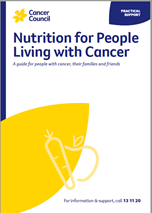- Home
- About Cancer
- Living well
- Nutrition and cancer
- Meal and snack ideas
Meal and snack ideas
When you feel too tired or unwell to shop for food or cook, or if you’re missing meals while having treatment, the quick meal and snack ideas in this section may help.
Learn more about:
- Overview
- Light meal and drink ideas
- Main meal ideas
- Snack ideas
- Simple meal recipes
- Nourishing drinks recipes
- Soup recipes
- Marinade recipes
- Video: Eating well after a cancer diagnosis
Overview
Some of these quick meal and snack ideas may not seem like healthy choices, but if you have a poor appetite it’s important to focus on high-protein and high-kilojoule food and fluids to ensure your body gets all the energy it needs. You can return to the healthy eating guidelines when your appetite improves.
Avoid foods that might make any treatment-related side effects worse (e.g. if you have a sore throat, do not eat dry, coarse snacks or acidic foods). If you have another health condition, such as diabetes, the suggestions here may not be suitable.
Check with your doctor or a dietitian before changing what you eat and drink while having cancer treatment.
Where to find recipes online
- From Treatment to Table collection of recipes for people with head and neck cancer. If you have trouble swallowing, the recipe book Beyond the Blender may help.
- For culturally relevant recipes for Chinese and Greek communities, visit cancer.org.au to see culturally diverse recipes (developed by the University of Tasmania’s Centre for Rural Health).
- For healthy recipe ideas, visit livelighter.com.au.
Light meal and drink ideas
- baked beans on toast with grated cheese
- crumpets or muffins toasted with cheese, and a piece of fruit
- scrambled or poached egg on toast and a glass of orange juice
- tuna or sardines on buttered toast with fresh tomato
- omelette with cheese or mushrooms and buttered bread
- toast with cheese, avocado or peanut butter, followed by sliced banana and yoghurt
- cereal or toasted muesli with full-cream milk and yoghurt
- porridge or rice pudding made with milk and cream
- congee
- pancakes or French toast with fruit and maple syrup
Nourishing drinks
These drinks are high in protein, energy, vitamins and minerals:
- enriched milk mixed with Akta-Vite, Milo or Horlicks
- milkshake
- banana smoothie
- mango lassi
- hot chocolate
- flavoured milk
- apricot lemon crush
Main meal ideas
- fresh or frozen fish with chips and salad
- grilled lamb cutlets, mashed potato with margarine or butter, and peas and carrots
- pasta with a ready-made sauce, e.g. pesto or bolognaise, and cheese
- cheesy vegetable bake
- lentil dhal with chapatis or rice
- green or red chicken or vegetable curry with basmati rice
- salmon, tuna or egg with store-bought mayonnaise, salad and buttered bread roll
- frozen or fresh lasagne or moussaka
- frittata or quiche
- salmon or tofu with soba noodles
- occasional takeaway such as noodles, stir-fry, curry and rice, hamburgers or pizza (ensure the food is freshly cooked)
- refrigerated leftover food from the previous day – reheat till steaming
- microwave potato with baked beans and cheese
- egg, tempeh and cooked vegetables with gado gado (peanut) dressing
- wrap with falafel, hummus and salad
Snack ideas
- crackers with cheese
- pita bread with hummus
- buttered pikelets, scones, muffins, fruit buns, crumpets, finger buns or raisin toast
- celery with cream cheese or peanut butter
- hard-boiled eggs
- dried fruit and nuts
- jaffles, sandwiches and toast – try egg and store-bought mayonnaise, cheese, peanut butter, avocado, tinned salmon or tuna
- milk puddings, such as creamed rice, rice pudding, custard, mousse and instant puddings
- fruit (fresh, frozen or tinned) with custard, yoghurt, jelly, ice-cream, cream or condensed milk
- stewed fruit with custard or cream
- creamy soup with added cream, and buttered toast
- hot chips, chicken nuggets or fish fingers
- instant noodles with frozen vegetables
- potato crisps, pretzels or corn chips with dips, salsa or guacamole
- yoghurt or ice-cream
- frozen sausage rolls, meat pies, samosas or spring rolls
→ READ MORE: Simple meal recipes
Video: How to eat well after a cancer diagnosis
Podcast: Appetite Loss and Nausea
Listen to more episodes from our podcast for people affected by cancer
More resources
Jacqueline Baker, Senior Oncology Dietitian, Chris O’Brien Lifehouse, NSW; Lauren Atkins, Advanced Accredited Practising Dietitian, OnCore Nutrition, VIC; Dr Tsien Fua, Head and Neck Radiation Oncology Specialist, Peter MacCallum Cancer Centre, VIC; Rosemerry Hodgkin, 13 11 20 Consultant, Cancer Council WA; Clare Hughes, Manager, Nutrition Unit, Cancer Council NSW; John Spurr, Consumer; Emma Vale, Senior Dietitian, GenesisCare, SA; David Wood, Consumer.
View the Cancer Council NSW editorial policy.
View all publications or call 13 11 20 for free printed copies.

